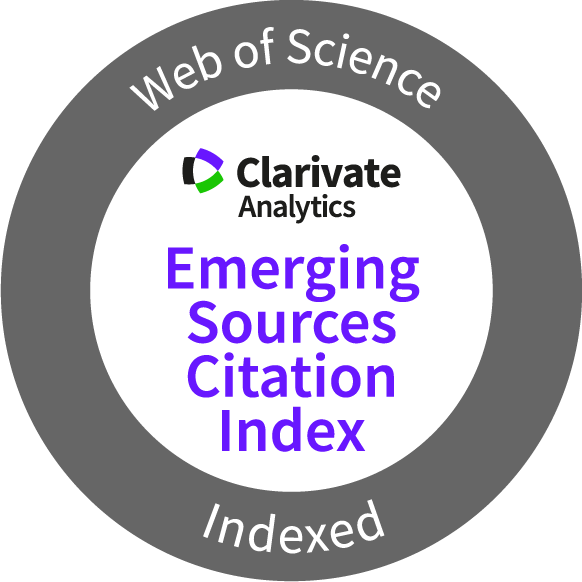Chemistry Journal of Moldova
Physical chemistry and chemical physics
Author(s):
Field: Physical chemistry and chemical physics
Type: Short communication
Issue: 2018 Volume 13, no.2
Pages: 89-92
Oksana Stavinskaya, Iryna Laguta, Olga Kazakova, Pavlo Kuzema, Tudor Lupascu
Field: Physical chemistry and chemical physics
Type: Short communication
Issue: 2018 Volume 13, no.2
Pages: 89-92
Full Text (PDF): Download
Abstract (PDF)
Graphical Abstract: Enoxil-silica composites with various Enoxil-to-silica ratios were prepared by mechanical mixing of the biologically active Enoxil and fumed silica powders. The hygroscopic properties of the composites were studied by the gravimetric method. . It was found that hygroscopicity is reduced by 30÷40% when the Enoxil-to-silica mass ratio in the composites is 0.15÷0.35.

Holding time in desiccators: 92 (1), 141 (2) and 365 (3) days.
Downloads: 83
Author(s):
Field: Physical chemistry and chemical physics
Type: Research paper
Issue: 2018 Volume 13, no.1
Pages: 103-110
Iurie Ungureanu, Gheorghe Duca, Ionel Humelnicu, Gelu Bourceanu
Field: Physical chemistry and chemical physics
Type: Research paper
Issue: 2018 Volume 13, no.1
Pages: 103-110
Full Text (PDF): Download
Graphical Abstract: This contribution presents investigations into possible effects of Ce3+ and Mn2+ on the reduction of UV-spectral signal for I3- observed e.g. in the Dushman reaction. The potential of the metal ions to form complexes with iodine-containing species was analysed. It was shown that no complex ions are formed between Ce3+ and Mn2+ metals ions with IO3-, I-, I2 species. Only the formation of a very weak CeI32+ complex ion was found to occur. An effect of a complex formation on the studied systems could be excluded.
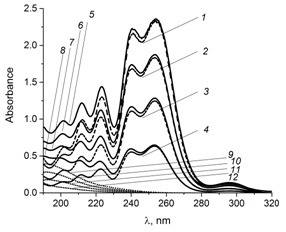

Downloads: 100
Author(s):
Field: Physical chemistry and chemical physics
Type: Research paper
Issue: 2018 Volume 13, no.1
Pages: 95-102
Is Fatimah, Nurul Indriani
Field: Physical chemistry and chemical physics
Type: Research paper
Issue: 2018 Volume 13, no.1
Pages: 95-102
Full Text (PDF): Download
Graphical Abstract: Green synthesis of silver nanoparticles (AgNPs) using Lantana camara yellow flower extract via microwave irradiation and ultrasound methods was conducted. The research was aimed at evaluating the effect of the synthesis method and also the time of treatment during synthesis on the particle size and antioxidant and antibacterial activities of the AgNPs. Analysis of the nanoparticles was performed using UV-Vis spectroscopy, transmission electron microscope (TEM), particle size analyzer, and Fourier transform infrared spectroscopy (FTIR). The present results support the advantages of plant extract and the green method for the production of nanoparticles for further potential applications.
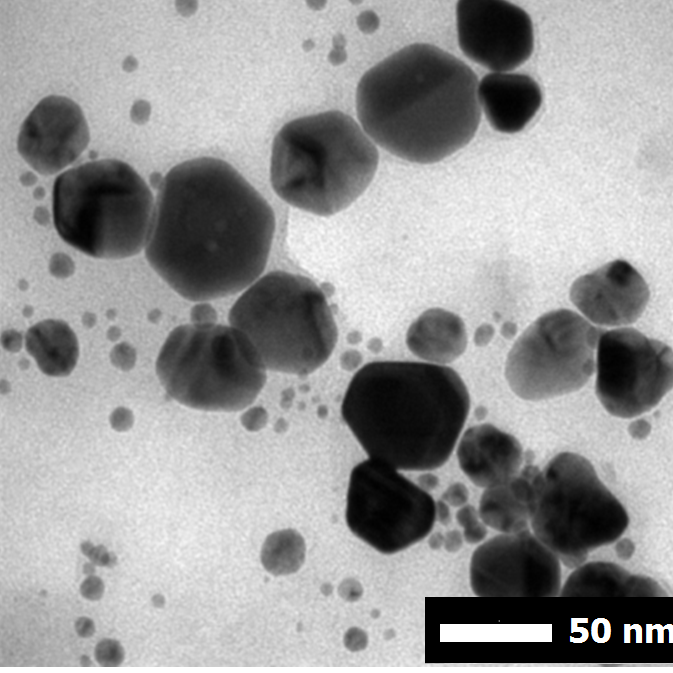

Downloads: 215
Author(s):
Field: Physical chemistry and chemical physics
Type: Research paper
Issue: 2018 Volume 13, no.1
Pages: 87-94
Volodymyr Turov, Viktor Bogatyrev, Tatiana Krupska, Mariia Galaburda, Tudor Lupascu, Igor Povar, Natalia Kokosha
Field: Physical chemistry and chemical physics
Type: Research paper
Issue: 2018 Volume 13, no.1
Pages: 87-94
Full Text (PDF): Download
Graphical Abstract: The state of water in a polyacrylamide (PPA) gel has been studied by the 1H NMR spectroscopy. It is shown that the PAA gel can serve as a container for prolonged retention of the Enoxil preparation without changing its chemical composition. At the same time, the molecular structures of Enoxil bind strongly to polymer chains, probably due to the formation of hydrogen-bound complexes with amino and imino groups.
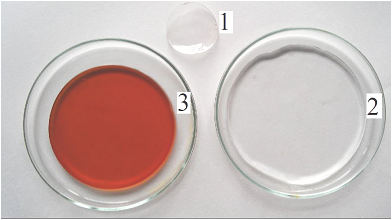

1 - initial dry PAA, 2 - hydrogel PAA,
3 - hydrogel PAA-Enoxil
Downloads: 65
Author(s):
Field: Physical chemistry and chemical physics
Type: Research paper
Issue: 2017 Volume 12, no.2
Pages: 87-101
Nadiia Roik, Lyudmila Belyakova, Marina Dziazko, Iryna Trofymchuk
Field: Physical chemistry and chemical physics
Type: Research paper
Issue: 2017 Volume 12, no.2
Pages: 87-101
Full Text (PDF): Download
DOI: http://dx.doi.org/10.19261/cjm.2017.419
Abstract (PDF)
Graphical Abstract: MCM-41-type silicas were obtained by template-assisted condensation of TEOS and β-CD-silanes. Removal of methyl red from phosphate buffer solutions as a function of pH and dye equilibrium concentration. Introduction of cyclic oligosaccharide in silica surface layer leads to the ecnhancement of sorption effieciency towards methyl red.

Downloads: 115
Author(s):
Field: Physical chemistry and chemical physics
Type: Research paper
Issue: 2017 Volume 12, no.2
Pages: 79-86
Oksana Dudarko *, Yuriy Zub
Field: Physical chemistry and chemical physics
Type: Research paper
Issue: 2017 Volume 12, no.2
Pages: 79-86
Full Text (PDF): Download
Abstract (PDF)
Graphical Abstract: The direct template method was used for the synthesis of mesoporous organosilica sorbents of SBA-15 type with phosphonic acid groups using sodium metasilicate (SS) as a source of silica. The presence of functional groups in the synthesized samples was confirmed by IR spectroscopy and elemental analysis. This approach allowed producing relatively cheap materials with ordered structure, developed specific surface (550-700 m2/g) and high sorption volume (0.74-0.81 cm3/g). The optimal sodium metasilicate (SS):diphosphoethyltriethoxysilane (DPTS) ratio for the synthesis of SBA-15 type organosilicas with phosphonic acid residues was found to be 10:2.

Graphical Abstract: The direct template method was used for the synthesis of mesoporous organosilica sorbents of SBA-15 type with phosphonic acid groups using sodium metasilicate (SS) as a source of silica. The presence of functional groups in the synthesized samples was confirmed by IR spectroscopy and elemental analysis. This approach allowed producing relatively cheap materials with ordered structure, developed specific surface (550-700 m2/g) and high sorption volume (0.74-0.81 cm3/g). The optimal sodium metasilicate (SS):diphosphoethyltriethoxysilane (DPTS) ratio for the synthesis of SBA-15 type organosilicas with phosphonic acid residues was found to be 10:2.

Downloads: 81
Author(s):
Field: Physical chemistry and chemical physics
Type: Research paper
Issue: 2017 Volume 12, no.2
Pages: 64-70
Emre Topal, Gökhan Gece
Field: Physical chemistry and chemical physics
Type: Research paper
Issue: 2017 Volume 12, no.2
Pages: 64-70
Full Text (PDF): Download
DOI: http://dx.doi.org/10.19261/cjm.2017.411
Graphical Abstract: The topic of corrosion inhibition of different metals by organic compounds has been the focus of intense scrutiny for decades. The enormity of the problem is reflected in the need to understand the underlying inhibition mechanisms of such compounds, one of which is the class of aliphatic amines. Electrochemical measurements represent protective effect of these compounds at ever-increasing levels of detail but these methods lack the resolution to represent inhibition efficiency-molecular structure relations adequately. In this study, the dependence of the inhibition effect of four aliphatic amines (methylamine, ethylamine, n-propylamine, and n-butylamine), on their molecular and electronic structure is analyzed using quantum chemical calculations. The obtained results of these calculations were found to be consistent with the experimental findings.


Downloads: 108
Author(s):
Field: Physical chemistry and chemical physics
Type: Research paper
Issue: 2017 Volume 12, no.1
Pages: 102-109
Andreea-Floriana Enache, Mircea Laurentiu Dan, Nicolae Vaszilcsin
Field: Physical chemistry and chemical physics
Type: Research paper
Issue: 2017 Volume 12, no.1
Pages: 102-109
Full Text (PDF): Download
Abstract (PDF)
Graphical Abstract: In this paper, anodic oxidation of sulphite ions on smooth nickel based 6 layers platinum nanoparticles electrode in aqueous alkaline solution was investigated in order to clarify the oxidation mechanism and to find optimal parameters for sulphite oxidation process, by applying various electrochemical methods of analysis.
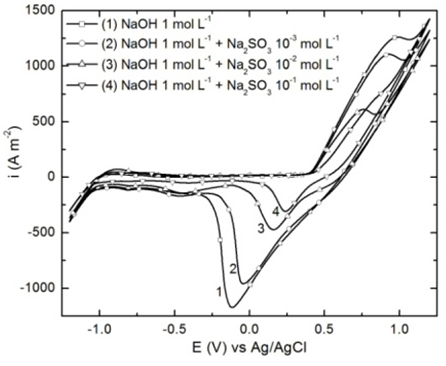
Graphical Abstract: In this paper, anodic oxidation of sulphite ions on smooth nickel based 6 layers platinum nanoparticles electrode in aqueous alkaline solution was investigated in order to clarify the oxidation mechanism and to find optimal parameters for sulphite oxidation process, by applying various electrochemical methods of analysis.

Downloads: 77
Author(s):
Field: Physical chemistry and chemical physics
Type: Research paper
Issue: 2017 Volume 12, no.1
Pages: 95-101
Vladimer Tsitsishvili, Nanuli Dolaberidze, Spartak Urotadze, Maia Alelishvili, Nato Mirdzveli, Manana Nijaradze
Field: Physical chemistry and chemical physics
Type: Research paper
Issue: 2017 Volume 12, no.1
Pages: 95-101
Full Text (PDF): Download
Abstract (PDF)
Graphical Abstract: Ion-exchange properties of natural zeolites of Georgia with a relatively low Si/Al ratio have been studied: analcimes are characterized by selectivity series: Na+>K+>Ag+>NH4+>Ca+2>Sr+2>Li+; for phillipsites selectivity sequences are different for calcium- and potassium forms; selectivity sequence for scolecite is: Sr+2>Ba+2>Rb+>Ca+2>Cs+>K+>NH4+>Na+>Mg+2>Li+>Cd+2>Cu+2> Mn+2> Zn+2>Co+2>Ni+2.

Graphical Abstract: Ion-exchange properties of natural zeolites of Georgia with a relatively low Si/Al ratio have been studied: analcimes are characterized by selectivity series: Na+>K+>Ag+>NH4+>Ca+2>Sr+2>Li+; for phillipsites selectivity sequences are different for calcium- and potassium forms; selectivity sequence for scolecite is: Sr+2>Ba+2>Rb+>Ca+2>Cs+>K+>NH4+>Na+>Mg+2>Li+>Cd+2>Cu+2> Mn+2> Zn+2>Co+2>Ni+2.

Downloads: 125
Author(s):
Field: Physical chemistry and chemical physics
Type: Short communication
Issue: 2017 Volume 12, no.1
Pages: 115-118
Saeid Taghavi Fardood, Ali Ramazani, Sajjad Moradi
Field: Physical chemistry and chemical physics
Type: Short communication
Issue: 2017 Volume 12, no.1
Pages: 115-118
Full Text (PDF): Download
Graphical Abstract: Present work involves synthesis of NiO nanoparticles using Arabic gum by the sol-gel method. The synthesized NiO nanoparticles were characterized by Fourier transform infrared spectroscopy (FTIR), field emission scanning electron microscopy (FESEM) and X-ray powder diffraction (XRD). It was shown that the synthesized NiO nanoparticles of cubic phase have a spherical shape and an average size of 34 nm.


Downloads: 750


